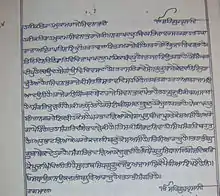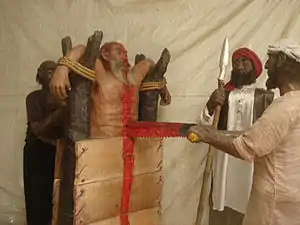Bhat Sikhs
The Bhat Sikhs (also known as Bhatra Sikhs) are a sub-group within the Sikhs who originated from the bards of the time of Guru Nanak.[1]
 The Nishan Sahib, flag of the Sikhs | |
 Hakikat-Rah-Muqaam-Shivnabh-Raje-Ki, description of the meeting of Guru nanak and Raja Shivnabh [p.1248] of an early 18th Century handwritten copy of Bhai Bannu’s Bir, the start of the Sikh Bhat Sangat. | |
| Languages | |
|---|---|
| Among the Sikh diaspora English, Sindhi, Hindi, Urdu, Swahili, Malay, Thai and others. | |
| Religion | |
| Sikhism Bhat Sikhs |
Introduction to the Bhat Sikhs
Sikhism

In the 17th century Bhats Bhai Mati Das and Bhai Sati Das were Saraswat Mohyal Brahmin.[2][3]
They were a small clan compared to others and many people in india did not know of them.[4] Though some lived in Lahore, many Bhat can trace their roots to villages around Sialkot and Gurdaspur Districts.[4]
| Part of a series on |
| Sikhism |
|---|
 |
Origins
Bhat is related to the Sanskrit word bhatta, a bard or poet.
Raja Shivnabh and Prince Baba Changa Rai
Guru Nanak met Raja Shivnabh, who was the grandfather of Changa Rai. The Guru bestowed the title of sangat on the Raja and his people, united seven kingdoms and made the Raja Shivnabh leader of them all.[5] Some scholars consider the Raja was the ruler of Batticaloa.[6]
M.S. Ahluwalia, a Senior Fellow at the Indian Council of Historical Research, New Delhi, offers historical evidence for Guru Nanak's presence in Sri Lanka, probably in the year 1510.[7] A place called Singaldeep or Sangladeep is often mentioned in 'Hakikat-Rah-Mukaam-Shivnabh-Raje-Ki' and is stated to be in Sri Lanka.
Bhat Sikhs in the United Kingdom
Jobs
The traditional Bhat profession of itinerant salesman, Businessmen and taxi drivers was useful to those arriving in the UK and was "a skill with considerable potential".[4] At first most Bhat, like some other Sikhs, worked either as doorstep or market traders (working with the Khatri community), but some settled in big cities like Leeds or Birmingham, gave up self-employment and took waged jobs in industry. (At this time many educated immigrants to Britain had difficulty finding employment suited to their qualifications and experience, because of racial and/or cultural prejudice.)
Bhat traders gradually moved into other roles as self-employed businessmen, often specialising in retailing. By the end of the 1950s selling door-to-door was less common and many British Bhat Sikhs moved towards commercial enterprises like market stalls, shops, supermarkets, and wholesale warehouses.[4]
‘One group of Sikhs who kept their turbans were a group called Bhartedas (sic)’.[8]
See also
- List of Sikhism-related topics
Bibliography
- Desh Pradesh, Differentiation and Disjunction among the Sikhs in South Asian Experience in Britain (1994) ed. Roger Ballard
- Roger Ballard, The Growth and Changing Character of the Sikh Presence in Britain in The South Asian Religious Diaspora in Britain, Canada, and the United States (2000), ed. Harold Coward, Raymond Brady Williams, John R Hinnells
- Roger Ballard, Migration,Remittances, Economic Growth and Poverty Reduction: Reflections on the basis of South Asian Experience
- R and C Ballard, The Sikhs: the development of South Asian settlements in Britain in Between Two Cultures ed. JL Watson (1977)
- P Ghuman, Bhattra Sikhs in Cardiff: Family and Kinship Organization. New Community (1980) 8, 3.
- Marie Gillespie, Television, Ethnicity and Cultural Change (Routledge 1995)
- Malory Nye, A Place for Our Gods: The Construction of an Edinburgh Hindu Temple Community (1995)
- Eleanor Nesbitt, Sikhism: A Very Short Introduction (OUP 2005) ISBN 0-19-280601-7
- Sikh settlers in Britain (includes material on caste and on "Bhattra")
References
- "Practices in Sikhism". BBC GCSE Eduqas. Retrieved 8 February 2021.
- O. P. Ralhan (1997). The Great Gurus of the Sikhs. Anmol Publications. p. 16. ISBN 978-81-7488-479-4.
His life-long companion Bhai Mati Das, a Mohyal Brahmin of village Karyala in Jehlam district...
- Hari Ram Gupta - Sikhs (1978). History of the Sikhs. Munshiram Manoharlal. p. 211.
The Guru's companions included Mati Das, a Mohyal Brahmin...
- Pradesh
- Haqiqat Rah Muqam shivnabh raje ki page 624 [p.1248]khari
- For more on Guru Nanak's journey to Batticaloa/Batticola see: Kirpal Singh, Janamsakhi Tradition (Amritsar 2004) Archived 24 March 2012 at the Wayback Machine
- M.S. Ahluwalia, Guru Nanak in Ceylon (Sikh Spectrum Quarterly 2004) Archived 4 November 2006 at the Wayback Machine
- The Irish Raj, 1997, p.174
